
OSGEMEOS’ ‘SEGREDOS’ Brings To Life The São Paulo Twins’ Vibrant Colourful Universe
21 July, 2021I wake up in the early hours, too excited to sleep. Today I will be visiting the OSGEMEOS exhibition, SEGREDOS (SECRETS). It is still dark when I emerge on the streets of Cambuci, São Paulo, Brazil. Workers hurry past or stand at street corner bakeries drinking milky cups of coffee to stave off the early morning cold. Televisions above their heads broadcast COVID data and information about São Paulo’s vaccine programme.
Otávio and Gustavo Pandolfo, the twin brothers behind the OSGEMEOS moniker (written in capitals as one word i.e. THETWINS) grew up in Cambuci. They still live here today. Small two-storey houses line most streets. It’s the sort of place where residents will know their neighbours… But change looms; and faceless high-rise apartment blocks tower over houses that lie empty. Cambuci’s central location is ripe for speculation and development. I soon pass by an OSGEMEOS work painted in bright letters. When I stop to take a photo, I realise that a homeless person is sleeping on the pavement.
The twins’ work in Cambuci showcases two very different, but complementary, art styles they use on the street. There are countless big, bold pieces of classic graffiti lettering painted with signature yellow fill and red outline. And there is a population of distinctive, other-worldly characters, distinguished by their spindly limbs, yellow skin and colourful, patterned clothes. The eye-catching big letter productions are visible from afar, but you might not spot a character until you pass one on the pavement and catch it gazing at you with mischievous or melancholic eyes.
I walk downhill, skirting Liberdade, São Paulo’s Japanese neighbourhood. Underneath an overhead motorway intersection, I find several enormous graffiti productions. Their letters stretch well above cars and the heads of pedestrians. Homeless people wrapped in grey blankets sleep near most of the pieces. Further under the overpass, I discover more works by the Gemeos; this time their characters. A hooded graffiti writer in colourful clothing who sprays a simple message; “There are many hungry people on the street”. Another nearby shows a child and a mother carrying a baby looking out at passers by next to the phrase, “There are many families on the street”. The baby is crying. A naked character leans, head against the wall, as if trying to hide from the world, or escape the destitution all around.
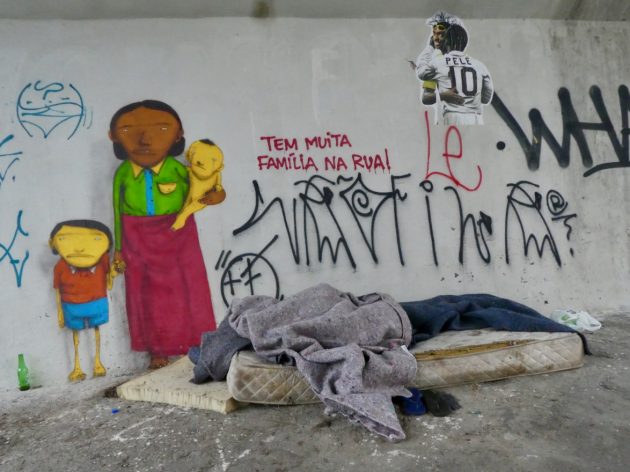
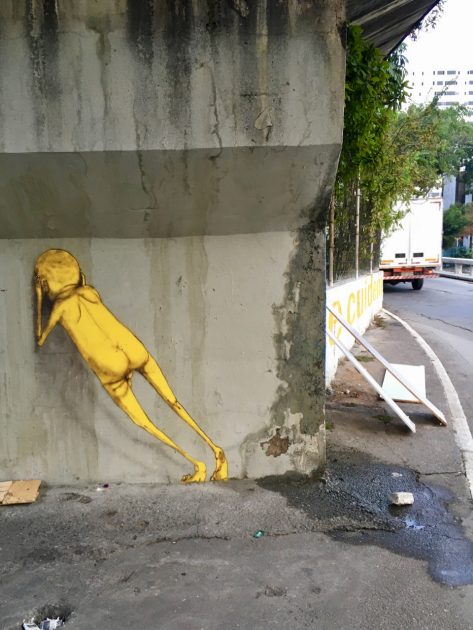
I kneel to take photos of the spraying character. Several humans sleep in front of the wall together with a dog that stares at me. I see feet and a head. Before I leave, I speak to the head, which belongs to a man. I give him a banknote. After all, this corner of São Paulo is his bedroom. It is a privilege to witness the twins’ art in its natural environment – a reward for my efforts in getting up early. Had I passed by later, I would not have seen the sleepers and I would not have understood that the paintings belong to the homeless. I carry on walking along the motorway. People lie metres from multiple lanes of rush hour traffic. There are more Gemeos works. The bright paintings, street sleepers, walls and cars merge into a single display of hope and despair, ugliness and beauty. The gallery is the city.
En route to the Pinacoteca, the art museum hosting the SEGREDOS exhibition, I gaze out of the car window. São Paulo is labyrinthine. Endless skyscrapers and motorways intertwine and decouple. You can suddenly come across a green area, or shoot across an overpass offering a panoramic view. It is an unexpected city and I am surprised to find myself looking at a wide, pleasant avenue I don’t recognise. I ask the driver its name. He doesn’t know. We both look at our phones. “Avenida Duque de Caxias”, I say, locating us on the map. But looking out of the window again, I’m confronted by a vision of uncountable homeless people, wrapped in the same grey blankets that covered the morning sleepers. There are tents and ramshackle lean-tos built from wood and plastic, and as we pass through a pretty square, we see medics in white coats and armed police. It looks like the day after a catastrophe.
I ask what has happened.
“Ah, this is Cracôlandia,” he says. “It’s always been bad, but it’s got worse since Covid hit.”
‘Crackland’ is the name given to a region in the city centre occupied by drug users. People avoid the area because of its dangerous reputation. Broken souls are everywhere. The driver winds up his windows and locks the doors. We pass policemen lining youths up against a wall at gunpoint.
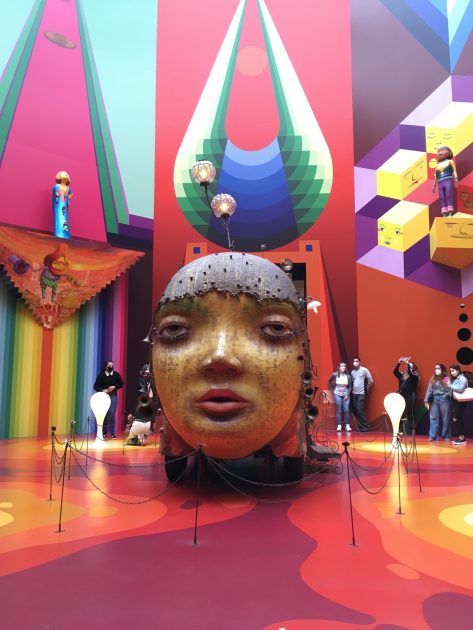
The Pinacoteca belongs to a different dimension. A well-tended park surrounds the handsome building. Inside, polite staff measure my temperature. I check my bag into a cloakroom, pass through a metal detector and follow a group of well-dressed visitors into an octagonal room drenched in colour and transformed into an OSGEMEOS artwork. Sunlight filters through the windows, settling on a wooden sculpture of a woman’s face that is part vehicle, part giant music box. On plinths high above my head, physical replications of the yellow-faced characters from the streets stand underneath mirrors and psychedelic shapes.
While works from OSGEMEOS are spread throughout the Pinacoteca, seven adjoining rooms constitute the exhibition proper. The first immerses the visitors in an intense red and blue spiral. Human characters emerge from the wall. A maiden dances between portraits and musical instruments, multiple faces woven into her hair. As I turn around, the red and blue spirals melt into an ocean. It is night. The moon is sinking into the sea where a man in patterned clothes floats on a heart. He holds a guitar. A lighthouse frames the exit, transforming it into a hopeful portal to SEGREDOS.
It makes sense for the Pinacoteca to host the twins’ first retrospective. In 1983, the brothers attended free art classes here. Teachers encouraged them to experiment with multiple media and disciplines; from painting and sculpture through to spray cans and performance. Creativity at home also enriched Gustavo and Otávio’s development. Their first studio was their bedroom. They practiced graffiti on the roof. Margarida, their mother, is an art and tapestry enthusiast – some of her work is on display at the Pinacoteca. Their grandfather loved opera. Their elder brother Arnaldo, who also contributes to the exhibition, loved to draw while listening to rock and heavy metal. And in 1983 they also discovered hip-hop.
This happy formula of family inspiration, artistic freedom, musical variety and the diverse, raw energy of hip-hop’s four elements – not only breakdance, rap, DJing and graffiti, but also, according to the brothers, “peace, love, togetherness and having fun” – underpins the twins’ inimitable creative universe. It also explains how and why OSGEMEOS transit with ease between the different cultural spheres of graffiti, street art and gallery shows. Art collectors across the world attach increasing value to their work, which they have exhibited in 60 countries.
The second room recounts their early years, beginning with childhood sketches and hip-hop paraphernalia from the twins’ personal collection. This includes numerous drawings and outlines, ‘Black Books’ of graffiti writers like Bando TCA, an authentic jacket worn by the cast of the 1984 film Beat Street, homemade tracksuits and sketchbooks, original work by underground cartoonist Vaughn Bodé and many photographs of the nascent 1980s Brazilian hip hop scene, centred around São Bento square in São Paulo.

The self-taught brothers always emphasise that gallery work and graffiti are different. Graffiti allows them to improvise and adapt to the moment, environment and conditions dictated by the unpredictable street. The Pinacoteca paintings and sculptures, on the other hand, testify to years of diligence and study in a controlled environment – their bedroom studio – through which they mastered varied forms and techniques.
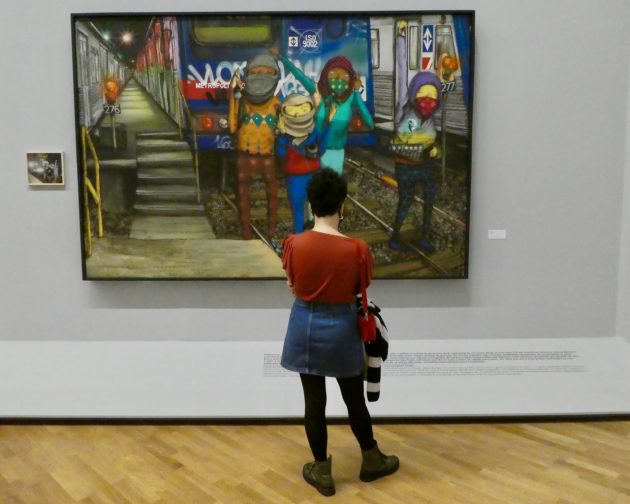
Further rooms house rich, bright oil paintings, a musical installation and sculpture made out of painted speakers and boom boxes, and a space dedicated to studies explaining, for the first time, the private universe the twins have imagined since childhood, a place they call ‘Tritrez’. While many paintings reference the world of graffiti and pay homage to its New York origins, others belong to Tritrez. And others are just fun. In “Flaming Hair”, a man with a yellow face wearing a pink shirt and red tie walks against a kaleidoscopic background of colour. In one hand he holds a can that he is using to paint his hair blue. In his other, he holds a leash attached to a dog, also sporting a lurid blue wig of paint. I laugh out loud.
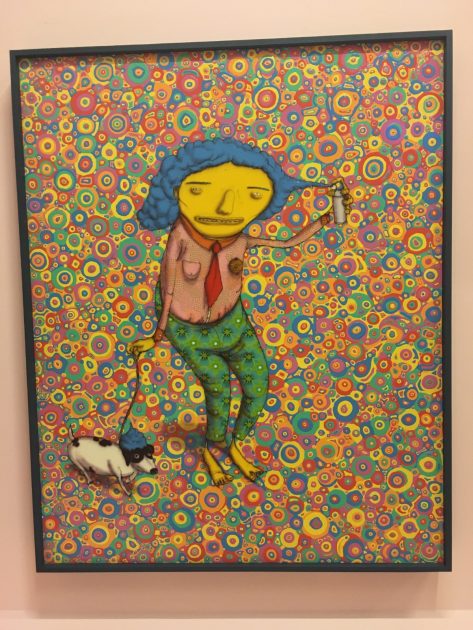
Because of COVID, a one-way system is in operation, meaning I cannot return to individual rooms once I have passed through. So I linger for as long as I can in each, moving with a mixture of sadness and excitement onto the next. Hundreds of different colourful outlines frame the entrance to the final room. These are the sort of sketches graffiti writers use when painting on the street or in train yards. Two Banksy collaborations hang inside, near photographs of the twins’ street characters. Here, some of their simplest, most ephemeral work is on display alongside what, in financial terms, are possibly their most valuable creations.
As I prepare to leave, I find myself standing next to a group of impeccably dressed, wealthy looking middle-aged women. After reflecting upon this, I realise that many Pinacoteca visitors must come from the upper echelons of São Paulo society. The ladies are enjoying what is perhaps their first public outing since the pandemic began. I’m grateful for OSGEMEOS and this exhibition. I’m grateful for this art of theirs, which has something for everyone.
SEGREDOS is at the Pinacoteca until 9th August. Watch the brothers introduce the exhibition here and see their four-part series on the history of São-Paulo hip-hop here (with English subtitles).
All photos by Damian Platt
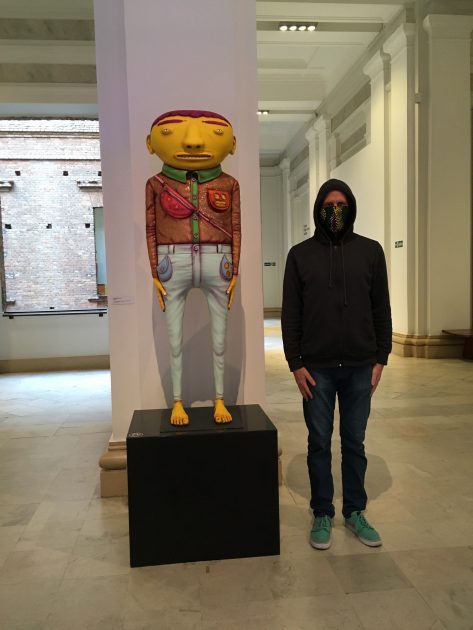
Follow Sounds and Colours: Facebook / Twitter / Instagram / Mixcloud / Soundcloud / Bandcamp
Subscribe to the Sounds and Colours Newsletter for regular updates, news and competitions bringing the best of Latin American culture direct to your Inbox.

